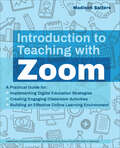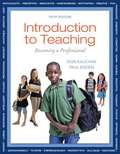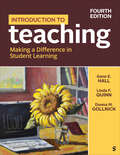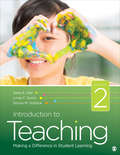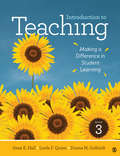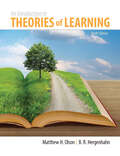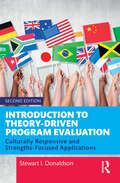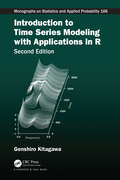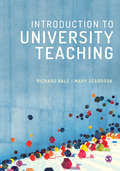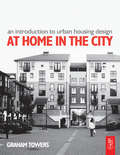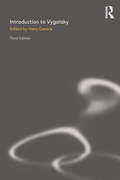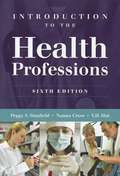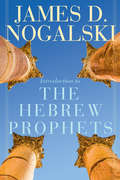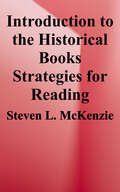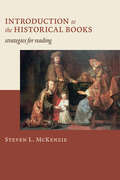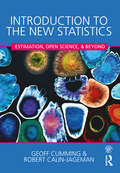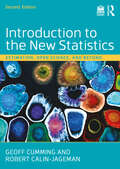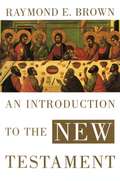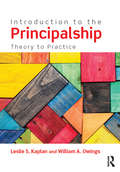- Table View
- List View
Introduction to Teaching with Webex
by M. JaneLearn to take your classroom curriculum digital using Cisco Webex&’s unique video conferencing features to create engaging lessons, collaborative activities, and more. Introduction to Teaching with Webex will help teachers of all grade levels master the basics of communication and education using the Cisco Webex video conferencing service. Learn how to connect with students, record your Webex meetings, control access to lessons, contribute to live chat streams, and conduct webinars. Webex newbie? No worries! Experienced educator and author M. Jane takes readers step-by-step through the most common Webex features and terminology. Packed with tips, tricks, troubleshooting, helpful screenshots, and activity ideas to keep students of all ages engaged, this book is indispensable as the future of teaching continues to evolve.
Introduction to Teaching with Zoom
by Madison SaltersA guide to using Zoom&’s unique video conferencing features to connect with students—and make learning more limitless. Introduction to Teaching with Zoom helps teachers of all grade levels master the basics of communication and education using the Zoom video conferencing service. With step-by-step instructions paired with helpful screenshots, you can learn how to connect with students, record your Zoom meetings, control access to lessons, contribute to live chat streams, and conduct webinars. Zoom newbie? No worries! Madison Salters takes you through the most common Zoom features and terminology. Whether public grade schools have been temporarily closed, or colleges and universities are looking to invest in distance learning, teachers need to be armed and ready to do what they do best no matter the platform. Packed with tips, tricks, troubleshooting, and lesson plans to keep students of all ages engaged, this book is indispensable as the future of teaching continues to evolve.
Introduction to Teaching: Becoming a Professional (Fifth Edition)
by Don Kauchak Paul EggenThe best-selling case-based text, Introduction to Teaching: Becoming a Professional, sharpens its focus on issues in education in its Fifth Edition. Weaving this focus throughout every chapter with new features and chapter sections covering diversity, reform, urban education, and technology, the text ensures that prospective teachers gather all the needed information to create an up-to-date picture of the ever changing face of education. The authors take this information and bring it to life with cases, classroom examples and videos, again ensuring that the living, changing, challenging and fulfilling life of an educator is as clear as it can be.
Introduction to Teaching: Making a Difference in Student Learning
by Donna M. Gollnick Gene E. Hall Linda F. QuinnGrounded in the realities and complexities of today’s schools, Introduction to Teaching: Making a Difference in Student Learning, Fourth Edition is the ideal text for aspiring teachers. Acclaimed authors Gene E. Hall, Linda F. Quinn, and Donna M. Gollnick thoroughly prepare students to make a difference as teachers, presenting first-hand stories and evidence-based practices while offering a student-centered approach to learning. From true-to-life challenges that teachers will face—reduced funding, low retention, and changing standards—to the inspiration and joy they will discover throughout their teaching careers, this text paints a realistic picture of the real life of a teacher in a post-pandemic era. This title is accompanied by a complete teaching and learning package. Contact your Sage representative to request a demo. Learning Platform / Courseware Sage Vantage is an intuitive learning platform that integrates quality Sage textbook content with assignable multimedia activities and auto-graded assessments to drive student engagement and ensure accountability. Unparalleled in its ease of use and built for dynamic teaching and learning, Vantage offers customizable LMS integration and best-in-class support. It’s a learning platform you, and your students, will actually love. Learn more. Assignable Video with Assessment Assignable video (available in Sage Vantage) is tied to learning objectives and curated exclusively for this text to bring concepts to life. Watch a sample video now. LMS Cartridge: Import this title’s instructor resources into your school’s learning management system (LMS) and save time. Don’t use an LMS? You can still access all of the same online resources for this title via the password-protected Instructor Resource Site. Learn more.
Introduction to Teaching: Making a Difference in Student Learning
by Donna M. Gollnick Gene E. Hall Linda F. QuinnGrounded in the realities and complexities of today’s schools, Introduction to Teaching: Making a Difference in Student Learning, Fourth Edition is the ideal text for aspiring teachers. Acclaimed authors Gene E. Hall, Linda F. Quinn, and Donna M. Gollnick thoroughly prepare students to make a difference as teachers, presenting first-hand stories and evidence-based practices while offering a student-centered approach to learning. From true-to-life challenges that teachers will face—reduced funding, low retention, and changing standards—to the inspiration and joy they will discover throughout their teaching careers, this text paints a realistic picture of the real life of a teacher in a post-pandemic era. This title is accompanied by a complete teaching and learning package. Contact your Sage representative to request a demo. Learning Platform / Courseware Sage Vantage is an intuitive learning platform that integrates quality Sage textbook content with assignable multimedia activities and auto-graded assessments to drive student engagement and ensure accountability. Unparalleled in its ease of use and built for dynamic teaching and learning, Vantage offers customizable LMS integration and best-in-class support. It’s a learning platform you, and your students, will actually love. Learn more. Assignable Video with Assessment Assignable video (available in Sage Vantage) is tied to learning objectives and curated exclusively for this text to bring concepts to life. Watch a sample video now. LMS Cartridge: Import this title’s instructor resources into your school’s learning management system (LMS) and save time. Don’t use an LMS? You can still access all of the same online resources for this title via the password-protected Instructor Resource Site. Learn more.
Introduction to Teaching: Making a Difference in Student Learning
by Gene E. Hall Linda F. Quinn Dr Donna M. GollnickIntroduction to Teaching: Making a Difference in Student Learning, Second Edition is the ideal text for aspiring teachers. Acclaimed authors Gene Hall, Linda Quinn, and Donna Gollnick thoroughly prepare teacher education candidates to make a difference as teachers, presenting first-hand stories and evidence-based practices while offering a student-centered approach to learning. The authors target one of the biggest challenges facing many of today’s schools—making sure that all students are learning—and help teachers make student learning the primary focus in all that they do. From true-to-life challenges that teachers will face (high-stakes testing, student learning assessments, low teacher retention, Common Core Standards) to the inspiration and joy they will discover throughout their teaching careers, this text paints a realistic picture of the real life of a teacher.
Introduction to Teaching: Making a Difference in Student Learning
by Gene E. Hall Linda F. Quinn Dr Donna M. GollnickIntroduction to Teaching: Making a Difference in Student Learning, Second Edition is the ideal text for aspiring teachers. Acclaimed authors Gene Hall, Linda Quinn, and Donna Gollnick thoroughly prepare teacher education candidates to make a difference as teachers, presenting first-hand stories and evidence-based practices while offering a student-centered approach to learning. The authors target one of the biggest challenges facing many of today's schools--making sure that all students are learning--and help teachers make student learning the primary focus in all that they do. From true-to-life challenges that teachers will face (high-stakes testing, student learning assessments, low teacher retention, Common Core Standards) to the inspiration and joy they will discover throughout their teaching careers, this text paints a realistic picture of the real life of a teacher.
Introduction to Teaching: Making a Difference in Student Learning
by Gene E. Hall Linda F. Quinn Dr Donna M. GollnickAn ideal introductory text for aspiring teachers, Introduction to Teaching: Making a Difference in Student Learning is grounded in the realities and complexities found in today’s schools. Acclaimed authors Gene E. Hall, Linda F. Quinn, and Donna M. Gollnick thoroughly prepare readers to make a difference as teachers, presenting firsthand stories and evidence-based practices while offering a student-centered approach to learning. The authors focus on how to address one of the biggest challenges facing many of today’s schools—ensuring that all students are learning—and help teachers prioritize student learning as their primary focus. From true-to-life challenges that future teachers will face, such as high-stakes testing, reduced funding, low retention, and Common Core State Standards, to the inspiration and joy they will experience throughout their teaching careers, the Third Edition paints an importantly authentic picture of the real life of a teacher.
Introduction to Teaching: Making a Difference in Student Learning
by Gene E. Hall Linda F. Quinn Dr Donna M. GollnickAn ideal introductory text for aspiring teachers, Introduction to Teaching: Making a Difference in Student Learning is grounded in the realities and complexities found in today’s schools. Acclaimed authors Gene E. Hall, Linda F. Quinn, and Donna M. Gollnick thoroughly prepare readers to make a difference as teachers, presenting firsthand stories and evidence-based practices while offering a student-centered approach to learning. The authors focus on how to address one of the biggest challenges facing many of today’s schools—ensuring that all students are learning—and help teachers prioritize student learning as their primary focus. From true-to-life challenges that future teachers will face, such as high-stakes testing, reduced funding, low retention, and Common Core State Standards, to the inspiration and joy they will experience throughout their teaching careers, the Third Edition paints an importantly authentic picture of the real life of a teacher.
Introduction to Theories of Learning: Ninth Edition
by Matthew H. OlsonDefines learning and shows how the learning process is studied. Clearly written and user-friendly, Introduction to the Theories of Learning places learning in its historical perspective and provides appreciation for the figures and theories that have shaped 100 years of learning theory research. The 9th edition has been updated with the most current research in the field. With Pearson's MySearchLab with interactive eText and Experiment's Tool, this program is more user-friendly than ever. Learning Goals Upon completing this book, readers should be able to: Define learning and show how the learning process is studied Place learning theory in historical perspective Present essential features of the major theories of learning with implications for educational practice Note: MySearchLab does not come automatically packaged with this text. To purchase MySearchLab, please visit: www.mysearchlab.com or you can purchase a ValuePack of the text + MySearchLab (at no additional cost).
Introduction to Theory-Driven Program Evaluation: Culturally Responsive and Strengths-Focused Applications
by Stewart I. DonaldsonIntroduction to Theory-Driven Program Evaluation provides a clear guide for practicing evaluation science, and numerous examples of how these evaluations actually unfold in contemporary practice. A special emphasis is placed how to conduct theory-driven program evaluations that are culturally responsive and strengths-focused. In this thoroughly revised new edition, author Stewart I. Donaldson provides a state-of-the art treatment of the basics of conducting theory-driven program evaluations. Each case follows a three-step model: developing program impact theory; formulating and prioritizing evaluation questions; and answering evaluation questions. The initial chapters discuss the evolution and popularity of theory-driven program evaluation, as well as step-by-step guide for culturally responsive and strengths-focused applications. Succeeding chapters provide actual cases and discuss the practical implications of theory-driven evaluation science. Reflections, challenges, and lessons learned across numerous cases from practices are discussed. The volume is of significant value to practicing evaluators, professors of introductory evaluation courses and their students, advanced undergraduate and graduate students, and serves as a text or a supplementary text for a wide range of evaluation and applied research courses. It is also of great interest to those interested in the connections between work and health, well-being, career development, human service organizations, and organizational improvement and effectiveness.
Introduction to Time Series Modeling with Applications in R (Chapman & Hall/CRC Monographs on Statistics and Applied Probability)
by Genshiro KitagawaPraise for the first edition: [This book] reflects the extensive experience and significant contributions of the author to non-linear and non-Gaussian modeling. … [It] is a valuable book, especially with its broad and accessible introduction of models in the state-space framework. –Statistics in Medicine What distinguishes this book from comparable introductory texts is the use of state-space modeling. Along with this come a number of valuable tools for recursive filtering and smoothing, including the Kalman filter, as well as non-Gaussian and sequential Monte Carlo filters. –MAA Reviews Introduction to Time Series Modeling with Applications in R, Second Edition covers numerous stationary and nonstationary time series models and tools for estimating and utilizing them. The goal of this book is to enable readers to build their own models to understand, predict and master time series. The second edition makes it possible for readers to reproduce examples in this book by using the freely available R package TSSS to perform computations for their own real-world time series problems. This book employs the state-space model as a generic tool for time series modeling and presents the Kalman filter, the non-Gaussian filter and the particle filter as convenient tools for recursive estimation for state-space models. Further, it also takes a unified approach based on the entropy maximization principle and employs various methods of parameter estimation and model selection, including the least squares method, the maximum likelihood method, recursive estimation for state-space models and model selection by AIC. Along with the standard stationary time series models, such as the AR and ARMA models, the book also introduces nonstationary time series models such as the locally stationary AR model, the trend model, the seasonal adjustment model, the time-varying coefficient AR model and nonlinear non-Gaussian state-space models. About the Author: Genshiro Kitagawa is a project professor at the University of Tokyo, the former Director-General of the Institute of Statistical Mathematics, and the former President of the Research Organization of Information and Systems.
Introduction to University Teaching
by Mary Seabrook Richard BaleThe essential guide to teaching and learning in higher education for early career academics, postgraduate researchers, graduate teaching assistants and professional services staff. This accessible text offers practical guidance for anyone new to teaching in higher education. It covers key aspects of teaching and learning relevant for early career academics, postgraduate researchers, graduate teaching assistants and professional services staff, including those working towards Advance HE/Higher Education Academy (HEA) recognition. Understand how to plan and evaluate teaching sessions, the dynamics of teaching in small and large groups, how to use technology effectively, the particular challenges of laboratory and fieldwork and the importance of inclusive practice and career development. Key features include: · Practical strategies to enhance student learning and motivation. · Case studies from higher education professionals in various roles · Activities and reflection points applying educational principles to your own teaching · Chapter links to the UK Professional Standards Framework (UKPSF)
Introduction to University Teaching
by Mary Seabrook Richard BaleThe essential guide to teaching and learning in higher education for early career academics, postgraduate researchers, graduate teaching assistants and professional services staff. This accessible text offers practical guidance for anyone new to teaching in higher education. It covers key aspects of teaching and learning relevant for early career academics, postgraduate researchers, graduate teaching assistants and professional services staff, including those working towards Advance HE/Higher Education Academy (HEA) recognition. Understand how to plan and evaluate teaching sessions, the dynamics of teaching in small and large groups, how to use technology effectively, the particular challenges of laboratory and fieldwork and the importance of inclusive practice and career development. Key features include: · Practical strategies to enhance student learning and motivation. · Case studies from higher education professionals in various roles · Activities and reflection points applying educational principles to your own teaching · Chapter links to the UK Professional Standards Framework (UKPSF)
Introduction to Urban Housing Design: At Home In The City
by Graham TowersThis clear and concise guide is the ideal introduction to contemporary housing design for students and professionals of architecture, urban design and planning. With the increasing commitment to sustainable design and with an ever-increasing demand for houses in urban areas, housing design has taken on a new and crucial role in urban planning. This guide introduces the reader to the key aspects of housing design, and outlines the discussion about form and planning of urban housing. Using chapter summaries and with many illustrations, it presents contemporary concerns such as energy efficient design and high density development in a clear and accessible way. It looks at practical design solutions to real urban problems and includes advice on reclamation and re-use of buildings. The guidance it presents is universally relevant. Part two of the book features current case studies that illustrate the best in high density, sustainable housing design providing the reader with design information, and design inspiration, for their own projects.
Introduction to Vygotsky
by Harry DanielsThis thoroughly updated third edition provides students with an accessible overview of Vygotsky’s work, combining reprints of key journal and text articles with rich editorial commentary. Lev Vygotsky provided the twentieth century with an enticing mix of intellectual traditions within an attempt to provide an account of the social formation of the mind. His legacy is an exciting, but at times challenging fusion of ideas. Retaining a multi-disciplinary theme, Introduction to Vygotsky, 3rd edition begins with a review of current interpretations of Vygotksy’s original work. Harry Daniels goes on to consider the development of Vygotsky’s work against a backdrop of political turmoil in the developing USSR. Major elements explored within the volume include the use of the 'culture' concept in social development theory, the development of means of describing social life, the concept of mediation, and implications for teaching, learning and assessment This book will be essential reading for Vygotskian students in developmental psychology, education and social sciences, as well as to students on specialised courses on cultural, cross-cultural and socio-cultural psychology, philosophical psychology, philosophy of science, history of psychology and Soviet/Russian history.
Introduction to the Bible: The Nature, History, Authorship and Content of the Holy Bible with Selections from and Commentaries on the Various Books
by John Laux Carl J. RyanCatholics who feel lost when facing Bible study will find this an extremely valuable, very thorough orientation to Sacred Scripture. Gives an introduction to each of the Bible's 72 books, with well-chosen Scriptural passages, using the Douay-Rheims Bible.
Introduction to the Health Professions (Sixth Edition)
by Nanna Cross Y. H. Hui Peggy S. StanfieldCompletely updated, Introduction to the Health Professions, Sixth Edition provides the most current, comprehensive coverage of all the major health professions. This popular text outlines more than 75 careers and touches on every major facet of the field including training requirements, job responsibilities, and salaries. This fundamental resource provides a thorough review of the U. S. healthcare delivery system, managed care, health care financing, reimbursement, insurance coverage, Medicare, Medicaid, and the impact of new technology on healthcare services. Written specifically for students who plan to become healthcare professionals, this text will give you all the information you need for a successful career! New Topics and Updates in the Sixth Edition Historical review of the health insurance industry in the United States Expanded discussion of public health care--Medicaid, Medicare, and Children's Health Insurance Program (CHIP)New section on healthcare reform due to the Patient Protection and Affordable Care Act of 2010Up-to-date coverage of individual states' implementation of healthcare reform Future-looking perspective on the evolving roles and responsibilities in health careers and the impact of future demographic and socioeconomic changes on healthcare needs Useful information on educational grants and loan repayment programs Current data for each profession from the latest Occupational Outlook (U. S. Department of Labor, 2010 - 2011)New chapter with current information on athletic trainers Instructor Resources: Transition Guide, Instructor's Manual, PowerPoint Presentations, and a Test Bank. Student Resources: Companion Website Instructors: Bundle this product with additional Jones & Bartlett introductory health professions texts and save your students up to 30% off list price. Contact your Account Specialist for more information.
Introduction to the Hebrew Prophets
by James D. NogalskiFollowing the Hebrew canon, the author offers a basic introduction, which includes critical issues such as authorship, unity, dates of composition and revision, and structure. Drawing upon current scholarship, Dr. Nogalski shows how these issues are relevant to the theological themes and movements that help characterize the text and hold meaning for us.The last decades have seen many changes when it comes to the study of the four Latter Prophets (Isaiah, Jeremiah, Ezekiel, and the book of the Twelve). Among others, these changes have identified a greater role for the prophetic scroll – not merely the prophetic character – as a vehicle for conveying the prophetic message. Nogalski’s introduction to the prophets invites modern readers to hear these scrolls through the processes that shaped them, to recognize the thematic threads that traverse them, and to react to the words that confront religious and ethical complacency, that speak truth to power, and that offer hope to the oppressed.Each chapter will include a brief bibliography for further reading and discussion questions to help students focus on key concepts.
Introduction to the Historical Books: Strategies for Reading
by Steven L. McKenzieThe author here surveys the historical books of the Old Testament—Joshua through Ezra-Nehemiah—for their historical context, contents, form, and themes, communicating them clearly and succinctly for an introductory audience. <p><p>By providing a better understanding of biblical history writing in its ancient context, the author helps readers come to terms with tensions between the Bible’s account and modern historical analyses. Rather than denying the results of historical research or dismissing its practitioners as wrongly motivated, he suggests that the source of the perceived discrepancy may lie not with the Bible but with the way in which it has been read. He also calls into question whether the genre of the Bible’s historical books has been properly understood.
Introduction to the Historical Books: Strategies for Reading
by Steven L. McKenzieSteven McKenzie here surveys the historical books of the Old Testament — Joshua through Ezra-Nehemiah — for their historical context, contents, form, and themes, communicating them clearly and succinctly for an introductory audience. / By providing a better understanding of biblical history writing in its ancient context, McKenzie helps readers come to terms with tensions between the Bible’s account and modern historical analyses. Rather than denying the results of historical research or dismissing its practitioners as wrongly motivated, he suggests that the source of the perceived discrepancy may lie not with the Bible but with the way in which it has been read. He also calls into question whether the genre of the Bible’s historical books has been properly understood.
Introduction to the New Statistics: Estimation, Open Science, and Beyond
by Geoff Cumming Robert Calin-JagemanThis is the first introductory statistics text to use an estimation approach from the start to help readers understand effect sizes, confidence intervals (CIs), and meta-analysis (‘the new statistics’). It is also the first text to explain the new and exciting Open Science practices, which encourage replication and enhance the trustworthiness of research. In addition, the book explains NHST fully so students can understand published research. Numerous real research examples are used throughout. The book uses today’s most effective learning strategies and promotes critical thinking, comprehension, and retention, to deepen users’ understanding of statistics and modern research methods. The free ESCI (Exploratory Software for Confidence Intervals) software makes concepts visually vivid, and provides calculation and graphing facilities. The book can be used with or without ESCI. Other highlights include: - Coverage of both estimation and NHST approaches, and how to easily translate between the two. - Some exercises use ESCI to analyze data and create graphs including CIs, for best understanding of estimation methods. -Videos of the authors describing key concepts and demonstrating use of ESCI provide an engaging learning tool for traditional or flipped classrooms. -In-chapter exercises and quizzes with related commentary allow students to learn by doing, and to monitor their progress. -End-of-chapter exercises and commentary, many using real data, give practice for using the new statistics to analyze data, as well as for applying research judgment in realistic contexts. -Don’t fool yourself tips help students avoid common errors. -Red Flags highlight the meaning of "significance" and what p values actually mean. -Chapter outlines, defined key terms, sidebars of key points, and summarized take-home messages provide a study tool at exam time. -http://www.routledge.com/cw/cumming offers for students: ESCI downloads; data sets; key term flashcards; tips for using SPSS for analyzing data; and videos. For instructors it offers: tips for teaching the new statistics and Open Science; additional homework exercises; assessment items; answer keys for homework and assessment items; and downloadable text images; and PowerPoint lecture slides. Intended for introduction to statistics, data analysis, or quantitative methods courses in psychology, education, and other social and health sciences, researchers interested in understanding the new statistics will also appreciate this book. No familiarity with introductory statistics is assumed.
Introduction to the New Statistics: Estimation, Open Science, and Beyond
by Geoff Cumming Robert Calin-JagemanThis fully revised and updated second edition is an essential introduction to inferential statistics. It is the first introductory statistics text to use an estimation approach from the start and also to explain the new and exciting Open Science practices, which encourage replication and enhance the trustworthiness of research. The estimation approach, with meta-analysis (“the new statistics”), is exactly what’s needed for Open Science.Key features of this new edition include: Even greater prominence for Open Science throughout the book. Students easily understand basic Open Science practices and are guided to use them in their own work. There is discussion of the latest developments now being widely adopted across science and medicine. Integration of new open-source esci (Estimation Statistics with Confidence Intervals) software, running in jamovi. This is ideal for the book and extends seamlessly to what’s required for more advanced courses, and also by researchers. See www.thenewstatistics.com/itns/esci/jesci/. Colorful interactive simulations, including the famous dances, to help make key statistical ideas intuitive. These are now freely available through any browser. See www.esci.thenewstatistics.com/. Coverage of both estimation and null hypothesis significance testing (NHST) approaches, with full guidance on how to translate between the two. Effective learning strategies and pedagogical features to promote critical thinking, comprehension and retention Designed for introduction to statistics, data analysis, or quantitative methods courses in psychology, education, and other social and health sciences, researchers interested in understanding Open Science and the new statistics will also appreciate this book. No familiarity with introductory statistics is assumed.A comprehensive website offers data sets, key term flashcards, learning guides, and videos describing key concepts and demonstrating the use of esci. For instructors, there are guides for teaching the new statistics and Open Science, assessment exercises, question banks, downloadable slides, and more. Altogether, the website provides engaging learning resources for traditional or flipped classrooms. See www.routledge.com/cw/cumming.
Introduction to the New Testament
by Raymond E. BrownEvery generation needs a comprehensive, reliable Introduction to the New Testament that opens the biblical text to the novice. Raymond E. Brown's An Introduction to the New Testament is the most trustworthy and authoritative guidebook for a generation seeking to understand the Christian Bible. Universally acknowledged as the dean of New Testament scholarship, Father Brown is a master of his discipline at the pinnacle of his career. Who else could cover the entire scope of the New Testament with such ease and clarity? This gifted communicator conveys the heartfelt concern of a beloved teacher for his students, as he walks the reader through the basic content and issues of the New Testament. While the book contains a wealth of information, its most impressive features are how the author boils down a life time of scholarship into basic summaries of each book, provides a historical overview of the ancient Greco-Roman world, engages in discussions of theological issues, and presents supplementary material for deeper understanding, such as tables, maps, bibliographies, and appendixes. Those opening to the New Testament for the first time and those seeking deeper insights could not ask for more in a primer to the Christian Bible.
Introduction to the Principalship: Theory to Practice
by Leslie S. Kaplan William A. OwingsThe latest leadership textbook from respected author team Kaplan and Owings explores how principals can effectively build a culture around student achievement. Introduction to the Principalship helps aspiring principals understand how to develop a vision for improvement, make decisions and manage conflict, build teachers’ capacity, communicate, monitor the organization’s performance, and create a school climate of mutual respect. This important book provides readers with various leadership concepts to inform their practice, as well as the cognitive and practical tools to evaluate and prioritize what leadership actions to take. Each chapter offers opportunities for readers to create personal meaning and explore new ways of doing leadership to advance a positive, person-focused environment. Providing both the theoretical framework and skills for effective practice, Introduction to the Principalship addresses the issues most urgent and relevant for educational leadership graduate students learning how to build a school culture that promotes every student’s success. Special Features: • Learning Objectives—chapter openers introduce the topic and initiate student thinking.• Reflections and Relevance —interactive exercises, role plays, class activities, and assignments help readers think about content in personally meaningful ways, facilitate understanding of chapter content, and help transfer leadership thinking to action in their own schools.• ISLLC Standards—each chapter is aligned to the 2015 Interstate School Leadership Licensure Standards.• Companion Website—includes links to supplemental material, additional readings, and PowerPoints for instructors.

